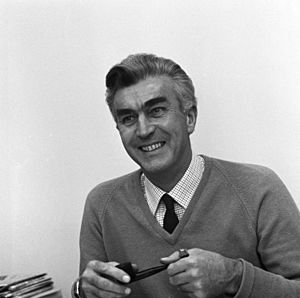John Adams (physicist) facts for kids
Quick facts for kids
John Adams
|
|
|---|---|

John Adams in his office at CERN
|
|
| Born | 24 May 1920 |
| Died | 3 March 1984 (aged 63) Geneva, Switzerland
|
| Other names | Sir John Bertram Adams |
| Occupation | Physicist and former CERN Director-General |
| Spouse(s) | Renie Warburton |
| Children | 2 |
Sir John Bertram Adams (born May 24, 1920 – died March 3, 1984) was a brilliant English scientist. He was an expert in building and running particle accelerators. These are huge machines that speed up tiny particles to study them.
John Adams is best known for his important work at CERN, a famous science lab in Europe. He also worked at the Culham Laboratory in the UK. Even though he didn't go to university, he worked for big science organizations. He even became the main leader, or Director-General, of CERN from 1976 to 1981.
Contents
About John Adams
Early Life and Learning
John Adams was born in Kingston, Surrey, England, on May 24, 1920. He went to Eltham College until he was 16. After that, he started working at Siemens Laboratories. He kept studying at a technical institute and earned a special certificate. This was the end of his formal schooling. He never went to a university.
His Amazing Career
At Siemens, John Adams worked on how telephones sound. During World War II, from 1940 to 1945, he helped develop important radar technology. Radar uses radio waves to detect objects.
Later, he moved to the Atomic Energy Research Establishment. In 1953, he joined the brand new CERN lab. There, he was in charge of building the Harwell Synchrocyclotron. This was Europe's first big particle accelerator. It worked for 30 years!
John Adams was also key in setting up how scientists would use CERN's new Proton Synchrotron. This machine started working in 1959. He helped organize everything, from the lab's structure to the equipment.
After CERN's first Director-General passed away in 1960, John Adams stepped in to lead the lab. He did this until 1961. Then, he went back to the UK to lead the Culham Fusion Laboratory. He also became a member of the United Kingdom Atomic Energy Authority. In 1963, he was made a Fellow of the Royal Society, a very respected group of scientists.
He returned to CERN in 1971. He helped design the Super Proton Synchrotron, another huge particle accelerator. He carefully managed CERN's new projects. His smart planning helped get money and approval for these big machines. His designs were reliable and allowed for future improvements. The Super Proton Synchrotron could make particles reach very high energies.
In 1976, CERN changed its leadership structure. John Adams became the main Director-General. He worked hard to get funding for the LEP collider. This new collider used special magnet systems that Adams had designed for his earlier accelerators. In 1981, he was honored with a knighthood, becoming "Sir" John Adams.
His Family Life
John Adams married Renie Warburton on January 24, 1943. They had two daughters and one son. He lived in a town called Founex in Switzerland.
Awards and Special Honors
John Adams received many awards for his important work:
- Rontegen Prize, University of Giessen (1960)
- Honorary Science Degree, University of Geneva
- Duddell Medal, Physical Society (1961)
- Honorary Science Degree, University of Birmingham (1961)
- Fellow of Royal Society (1963)
- Leverhulme Medal (Royal Society) (1972)
- Royal Medal, Royal Society (1977)
- Knight Bachelor (1981)
John Adams Institute for Accelerator Science
There's an important research center named after him! It's called the John Adams Institute for Accelerator Science (JAI). This institute studies accelerator physics. It includes scientists from Royal Holloway, University of London, University of Oxford, and Imperial College London. Also, a main road at CERN's Prevessin site is named "Route Adams" in his honor.
See also
- List of Directors General of CERN

